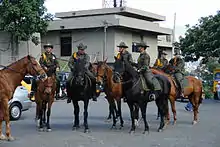

The Directorate of Carabineers and Rural Security of the National Police of Colombia supervises the Mounted Police, or Carabineros Corps, a rural paramilitary police force resulting from the 1993 reform to patrol and maintain public order in conflict zones and in the national parks.[1] Despite its reestablishment in 1993, the Carabineros Corps is actually Colombia's oldest police force, created by a law of May 18, 1841.[1] Beginning in 1936, a Chilean mission helped to professionalize the corps.[1]

The Carabineros carry out counterinsurgency missions, frequently in conjunction with army units.[2] Headquartered at the department and national territory capitals, the Carabineros are maintained in squadrons that were separate from those of the regular police; they wore distinctive uniforms and often traveled as mounted units.[2]
In 2006 there were 9,800 Carabineros officers, located principally in rural areas and trained in irregular conflict and in the rescue of hostages.[1]
Units of the Mobile Carabinier Squadrons (EMCAR), operating in 120-member squadrons, were formed in 2004 as a part of President Álvaro Uribe’s Democratic Security and Defense Policy (usually referred to as Democratic Security Policy) to provide extra support for police activities in conflict areas.[1] Special Carabineros Corps units also provide backup to urban police during public events or civil protests.[1]
See also
Notes
- 1 2 3 4 5 6
 This article incorporates text from this source, which is in the public domain: Mason, Ann C. (2010). "National Police". In Hudson, Rex A. (ed.). Colombia: a country study (5th ed.). Washington, D.C.: Federal Research Division, Library of Congress. p. 315. ISBN 978-0-8444-9502-6. OCLC 560551801.
This article incorporates text from this source, which is in the public domain: Mason, Ann C. (2010). "National Police". In Hudson, Rex A. (ed.). Colombia: a country study (5th ed.). Washington, D.C.: Federal Research Division, Library of Congress. p. 315. ISBN 978-0-8444-9502-6. OCLC 560551801. - 1 2
 This article incorporates text from this source, which is in the public domain: Walker, Phyllis Greene (1990). "The National Police and Law Enforcement Authorities". In Hanratty, Dennis M.; Meditz, Sandra W. (eds.). Colombia: a country study (4th ed.). Washington, D.C.: Federal Research Division, Library of Congress. p. 296. OCLC 756958957.
This article incorporates text from this source, which is in the public domain: Walker, Phyllis Greene (1990). "The National Police and Law Enforcement Authorities". In Hanratty, Dennis M.; Meditz, Sandra W. (eds.). Colombia: a country study (4th ed.). Washington, D.C.: Federal Research Division, Library of Congress. p. 296. OCLC 756958957.